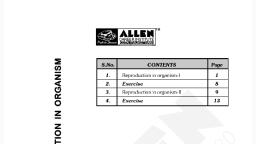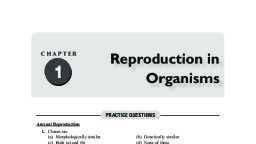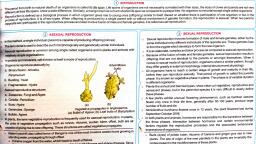Page 1 :
+4 Offspring formed due to sexual reproduction have, , Ans., , Ans., , Ans,, , better chances of survival. Why? Is this statement, always true?, , — Offspring formed by sexual reproduction show, genetic variation; variations enable these organisms, to survive better under unfavourable conditions., , ~ In lower organisms like algae and fungi, sexual, reproduction occurs at the end of favourable season, and the zygote formed develops a thick wall and, remains dormant during unfavourable conditions., This statement is not Always true because offspring, formed by oviparous animals with external, , fertilisation are vulnerable to predators and the, harsh environmental conditions., , 1S. How does the progeny formed from asexual, reproduction differ from those formed by sexual, reproduction?, , Ais. —, , The progeny formed from asexual reproduction has, individuals that are morphologically and genetically, identical; they are clones., Sexually reproduced individuals show genetic, variations and they are not genetically identical;, they are called offspring., , Distinguish between asexual and sexual reproduction. Why is vegetative reproduction also considered as a type, , of asexual reproduction?, , . Differences:, , , , A single parent is involved; it is uniparental., , — There is no formation or fusion of gametes., a It involves only mitotic divisions., , f=, , — Allindividuals produced are genetically identical, i.e. | —, , clone., {= _ Itisa simple process., , ak, , , , Two parents (a male and a female) are involved; it is, , , , , There is formation and fusion of gametes., , biparental., , It involves meiosis at some stage., All individuals produced exhibit variation, i.e., offspring., , It is an elaborate and complex process., , Vegetative reproduction involves a single parent and there is no formation and fusion of gametes; hence it is considered, , as asexual reproduction., , . What is vegetative propagation? Give two suitable, , examples., , Vegetative propagation is the process of formation, or regeneration of new plants from a portion ofa, vegetative part of the plant,, , eg. (i) offset of water hyacinth, (ii) epiphyllous buds of Bryophyllum, , . Define, , (a) Juvenile phase,, , (b) Reproductive phase,, , (c) Senescent phase., , (a) Juvenile phase is the period of growth of an, organism from birth till attaining reproductive, maturity., , (b) Reproductive phase refers to the period in the life, of an organism, after it attains reproductive/sexual, maturity, starts reproducing and has the ability to, reproduce till the beginning of senescent phase., , (c) Senescent phase refers to the period in the life of, , an organism between the end of sexual maturity, and death, when deteriorative changes take place, in the structure and/or functions of the organs., , 1.9., , Ans., , Ans., , Explain why meiosis and gametogenesis are always, interlinked?, , Meiosis occurs in diploid organisms during, gametogenesis or gamete formation; as a result,, the gametes become haploid., , By the fusion of two such haploid gametes, a diploid, zygote is formed and it develops involving mitotic, divisions., , Thus, meiosis maintains the characteristic number, of chromosomes (of a species) constant., , _ Define external fertilisation. Mention its dis, advantages., , When fusion of gametes occurs outside the body of, organisms (in the external medium like water), the, process is called external fertilisation., , Disadvantages:, , The chances of syngamy are less., , The chances of survival of offspring are much less, , as:, , © they are extremely vulnerable to predators, which, threaten their survival upto adulthood., , e they are also exposed to harsh environmental, conditions.




























































